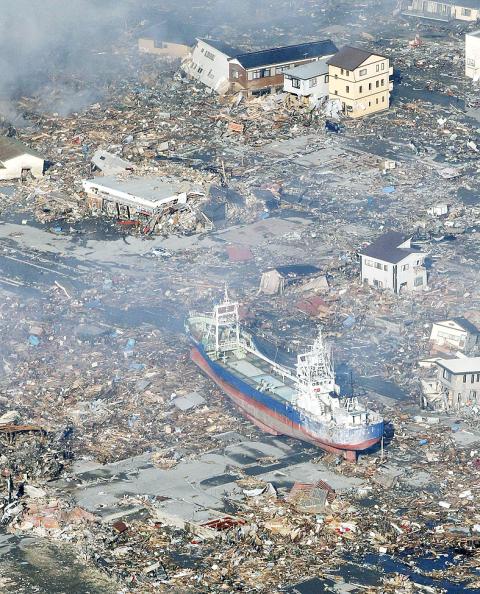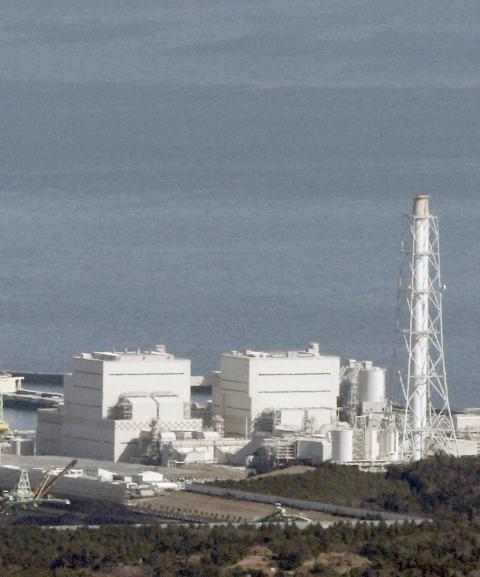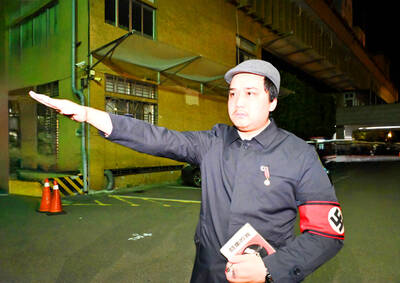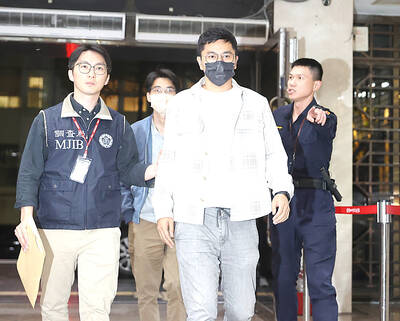An explosion and feared meltdown at a Japanese nuclear plant yesterday exposed the scale of the disaster facing the country after a massive quake and tsunami left more than 1,000 dead.
Japanese Prime Minister Naoto Kan said the magnitude 8.9 quake and the terrifying tsunami that followed were an “unprecedented national disaster” and vowed to protect those living near the stricken plant.
Reactor cooling systems failed at two nuclear facilities after Friday’s record earthquake, which unleashed a terrifying 10m tsunami that tore through coastal towns and cities, destroying everything in its path.

Photo: Reuters
Smoke was seen billowing from the Fukushima No. 1 atomic plant about 250km northeast of Tokyo after an explosion at the site.
Kyodo News agency said radioactive caesium had been detected near the aging facility, citing the nuclear safety agency.
However, Kan’s top spokesman, Yukio Edano, said that the Fukushima plant’s operator had reported the reactor container was not damaged and that radiation levels near it had fallen after the blast.

Photo: Reuters
Kyodo and Jiji reported before the explosion that the plant “may be experiencing nuclear meltdown,” while public broadcaster NHK quoted the safety agency as saying metal tubes that contain uranium fuel may have melted.
The cooling system of the plant was damaged in the massive earthquake that struck the region 24 hours earlier, leaving authorities scrambling to fix the problem and evacuate tens of thousands of people within a 20km radius.
Thousands were evacuated near another damaged plant, Fukushima No. 2.
The atomic emergency came as the country struggled to assess the full extent of the devastation wreaked by the massive tsunami, which was unleashed by the strongest quake ever recorded in Japan.
The wall of water pulverized towns and cities along the northeastern coast. Police reportedly said 200 to 300 bodies had been found in the city of Sendai.
About 300 to 400 bodies were recovered in Rikuzentakata, a coastal town of about 23,000 people, NHK quoted the military as saying.
The Fire and Disaster Management Agency said the tsunami had obliterated the town.
It was not immediately clear whether any of the bodies found by the military were included in police tolls showing at least 700 people dead. The government spokesman said at least 1,000 people were believed to have lost their lives.
More than 215,000 people were huddled in emergency shelters, police said.
The full scale of those left homeless was believed to be much higher, with police saying they had not received a tally from Miyagi Prefecture, the hard-hit region that is home to Sendai.
NHK reported that about 10,000 people are unaccounted for in the Japanese port town of Minamisanriku in Miyagi. The figure is more than half of the town’s population of about 17,000, it said.
Local authorities are trying to find their whereabouts with the help of Japan’s Self-Defense Forces, NHK said.
The raging tsunami picked up shipping containers, cars and the debris of shattered homes. It crashed through the streets of Sendai and across open fields, forming a mud slick that covered vast tracts of land.
“There are so many people who lost their lives,” an elderly man told TV reporters before breaking down in tears. “I have no words to say.”
Authorities said more than 3,000 homes were destroyed or swept away.
About 50,000 military and other rescue personnel were spearheading a Herculean rescue and recovery effort with hundreds of ships, aircraft and vehicles headed to the Pacific coast area.
Army helicopters airlifted people off the roof of an elementary school in Watari, Miyagi Prefecture.
In quake-hit areas, 5.6 million households had no power yesterday and more than 1 million households were without water. Telecommunications networks were also hit.
The quake, which hit at 2:46pm and lasted about two minutes, rattled buildings in greater Tokyo, the world’s largest urban area and home to about 30 million people.
More than 24 hours after the first, massive quake struck about 400km northeast of Tokyo, aftershocks were still rattling the region, including a strong magnitude 6.8 tremor yesterday.
The US Geological Survey said more than 100 aftershocks had hit the area.

Seventy percent of middle and elementary schools now conduct English classes entirely in English, the Ministry of Education said, as it encourages schools nationwide to adopt this practice Minister of Education (MOE) Cheng Ying-yao (鄭英耀) is scheduled to present a report on the government’s bilingual education policy to the Legislative Yuan’s Education and Culture Committee today. The report would outline strategies aimed at expanding access to education, reducing regional disparities and improving talent cultivation. Implementation of bilingual education policies has varied across local governments, occasionally drawing public criticism. For example, some schools have required teachers of non-English subjects to pass English proficiency

‘FORM OF PROTEST’: The German Institute Taipei said it was ‘shocked’ to see Nazi symbolism used in connection with political aims as it condemned the incident Sung Chien-liang (宋建樑), who led efforts to recall Democratic Progressive Party (DPP) Legislator Lee Kun-cheng (李坤城), was released on bail of NT$80,000 yesterday amid an outcry over a Nazi armband he wore to questioning the night before. Sung arrived at the New Taipei City District Prosecutors’ Office for questioning in a recall petition forgery case on Tuesday night wearing a red armband bearing a swastika, carrying a copy of Adolf Hitler’s Mein Kampf and giving a Nazi salute. Sung left the building at 1:15am without the armband and apparently covering the book with a coat. This is a serious international scandal and Chinese

TRADE: The premier pledged safeguards on ‘Made in Taiwan’ labeling, anti-dumping measures and stricter export controls to strengthen its position in trade talks Products labeled “made in Taiwan” must be genuinely made in Taiwan, Premier Cho Jung-tai (卓榮泰) said yesterday, vowing to enforce strict safeguards against “origin laundering” and initiate anti-dumping investigations to prevent China dumping its products in Taiwan. Cho made the remarks in a discussion session with representatives from industries in Kaohsiung. In response to the US government’s recent announcement of “reciprocal” tariffs on its trading partners, President William Lai (賴清德) and Cho last week began a series of consultations with industry leaders nationwide to gather feedback and address concerns. Taiwanese and US officials held a videoconference on Friday evening to discuss the

PERSONAL DATA: The implicated KMT members allegedly compiled their petitions by copying names from party lists without the consent of the people concerned Judicial authorities searched six locations yesterday and questioned six people, including one elderly Chinese Nationalist Party (KMT) member and five KMT Youth League associates, about alleged signature forgery and fraud relating to their recall efforts against two Democratic Progressive Party (DPP) legislators. After launching a probe into alleged signature forgery and related fraud in the KMT’s recall effort, prosecutors received a number of complaints, including about one petition that had 1,748 signatures of voters whose family members said they had already passed away, and also voters who said they did not approve the use of their name, Taipei Deputy Chief Prosecutor